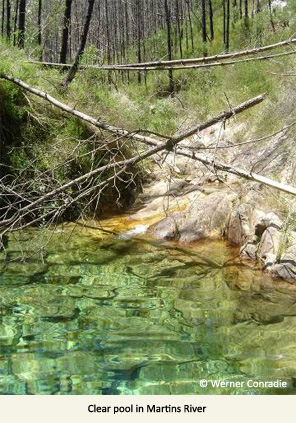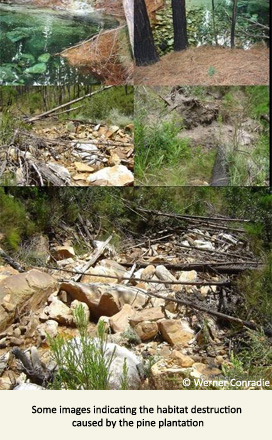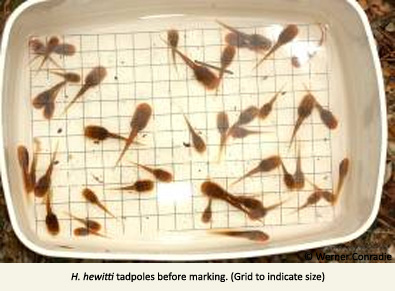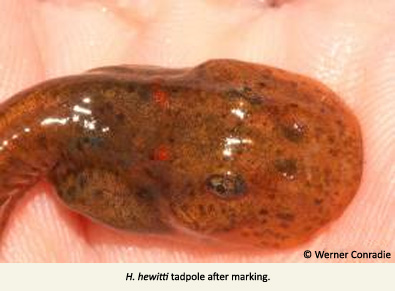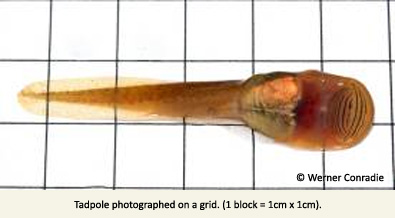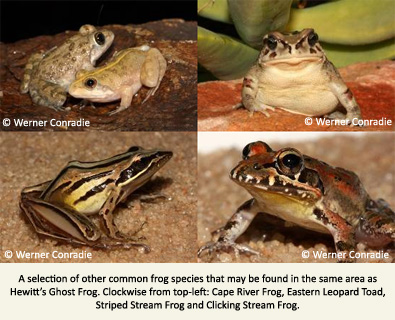Here is an update from Werner Conradie, our EDGE Fellow who is working to develop a robust monitoring regime for Hewitt’s ghost frog, working towards a conservation programme for this South African species.
A few fieldtrips were conducted in which habitat as well as threat assessments, the presence of other amphibian species were noted and photographed, and a selection of monitoring sites were selected in which tadpoles will be marked with Visible Implanted Elastomer (VIE) markers. The Ghost frog occurs in only four rivers in the Elandsberg, Eastern Cape Province, South Africa. Until recently, only two of the rivers were visited: the Martins- and Geelhoutboom Rivers.
Threats – The main and by far most important threat is the habitat degradation caused by the forestry practices of the past. The present environmental officers at the forestry are doing their best to improve the habitat for ghost frogs by advising the forestry staff in environmental practices. Most of the damaged was caused by big fires that spread rapidly a few years ago. These fires destroyed many of the pine trees, which fell and are presently falling over, causing clogging of the streams, which in turn causes siltation (especially after heavy rains). As the tadpoles depend on the algae growing on the rock bed of the streams for feeding, the siltation is proving to have a negative impact on the dispersal of these tadpoles. The local forestry industry tries to remove as much of these dead trees from the streams as possible, but this is not always possible or practical.
However, heavy floods in 2005 relieved the siltation impact by clearing the riverbed of silt, albeit temporarily. At present, some evidence of siltation is showing, but will hopefully improve again with more heavy rain. Another factor contributing to the siltation problem is pine needles. Overhanging pine trees are losing a lot of their pine needles, causing clogging of the streams, especially in the drier months when stream flow is reduced. No studies were as yet performed to see if the pine needles cause a change in pH, and this might prove difficult as no historical data on pH are available.
The pine trees in the upper catchments area of the rivers take up most of the precipitation, thus causing a reduced stream flow. This also has an impact on the ghost frog population, as the species’ tadpoles are depended on constant stream flow for survival. This chain of events is caused by the malpractice of the forestry industries in the past and it will take years to improve this situation, if ever.
VIE marking – Three monitoring sites were selected in the headwaters of the Geelhoutboom River. Tadpoles are collected with a dip-net and placed in a container with clean river water. Tadpoles are then transferred one by one to another container containing a weak MS-222 solution. These acts as an anaesthetic, and make it easier to handle the tadpoles. Tadpoles are then injected with different coloured markers, each colour connected to a specific site, and placed in another container with fresh river water to recover. The goal of the marking is to determine the movement of the tadpoles as well how they adapt to floods. An added benefit is a rough indication of the relative size and growth of the ghost frog population as a whole.
Tadpoles are put on 1cm x 1cm grid and photographed before VIE marking. This helps so that measurements can be taken later and saves a lot of time in the field. Take note of the big oral cavity; this is a benefit, for it makes it easier to swab the tadpoles for the presence of the amphibian chytrid (Batrachochytrium dendrobatidis), a disease which is threatening many amphibians and causing extinctions worldwide. The first results collected thus far, indicated that 70% of the tadpoles swabbed were infected with amphibian chytrid.
If you would like to support the conservation research and activities of EDGE Fellows, such as Werner, then please become an EDGE Champion, or donate here.
